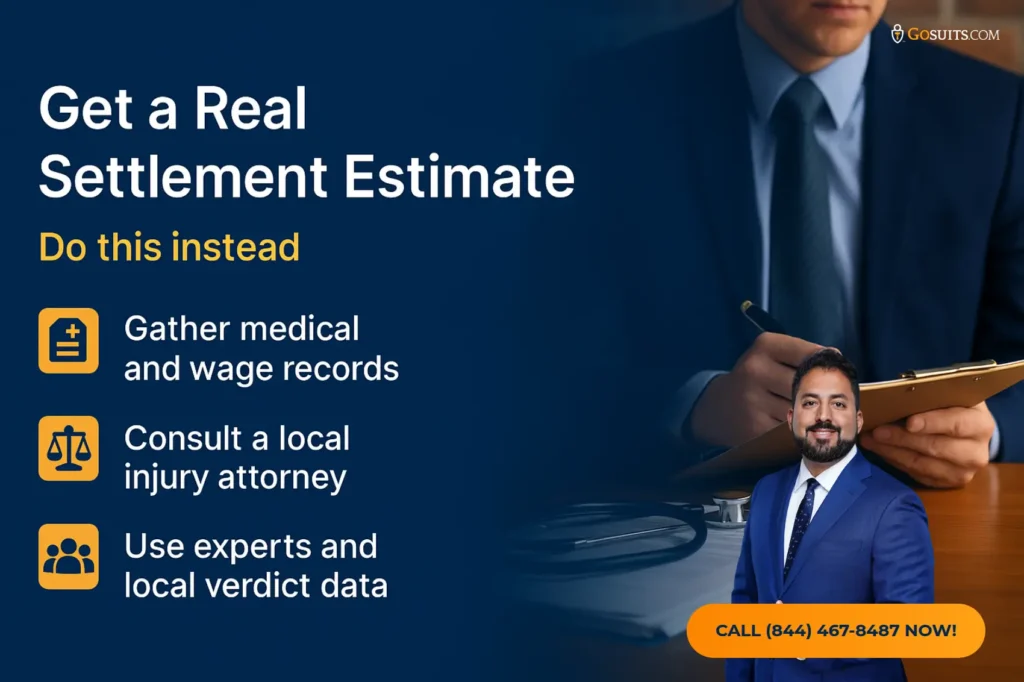- What are online personal injury case estimate calculators and how do they work?
- Are online personal injury calculators fake or fraudulent?
- How accurate are injury estimate tools and what limits their accuracy?
- What are the most common scams and red flags with online settlement calculators?
- Do calculators affect personal injury claims or settlement negotiations?
- How can I get a more reliable injury settlement estimate?
- How do federal law and the law in California, Texas, and Illinois change how calculators should be used?
- What should plaintiffs and defendants keep in mind when they see an online estimate?
- How often do insurers or courts rely on calculator outputs?
- What steps should you take next if you used an online personal injury calculator?
- About GoSuits and how a free consultation can help
- Resources
What are online personal injury case estimate calculators and how do they work?
Online personal injury calculators (also called injury settlement calculators or personal injury case estimate tools) are web-based forms that ask you to enter facts such as injury type, medical costs, lost earnings, age, and sometimes details about fault and jurisdiction. The site then returns an estimated settlement range or single figure.
Most calculators use simple formulas or statistical models that combine:
- economic damages: billed medical expenses, future medical costs, lost wages;
- non-economic damages: pain and suffering, loss of consortium, often calculated as a multiplier of economic damages or using a daily-rate method;
- adjustments: reductions for comparative fault, caps that may apply in a state, or insurer-specific factors.
Some are built on transparent rules; others use proprietary algorithms with little public explanation. Tools vary from simple spreadsheets to machine-learning models trained on past settlements. Because the assumptions and sample data differ widely, outputs will differ as well.
Where can I learn what counts as damages?
Authoritative descriptions of damage categories are available from legal reference resources like the Legal Information Institute at Cornell University (Wex), which explains economic, non‑economic, and punitive damages and how they operate in personal injury litigation: Cornell LII — Damages.

Are online personal injury calculators fake or fraudulent?
Not all online calculators are fraudulent, but some are misleading. Tools that clearly state assumptions, limitations, and sources can be useful as a starting point. Others are marketed to get clicks, harvest personal data, or steer users toward particular services and may give unrealistic figures.
Regulatory authorities have pursued companies that used deceptive online tools or ads to mislead consumers. For example, federal enforcement actions highlight that an online tool may be unlawful if it is used as part of advertising that makes deceptive claims about likely results or guarantees. See the FTC case record for a deceptive-marketing enforcement action where online calculators and representations were central to the agency’s claims: FTC v. Commerce Planet (C.D. Cal.). The Federal Trade Commission also publishes guidance for businesses about truthful advertising and online marketing: FTC — Advertising & Marketing.
How accurate are injury estimate tools and what limits their accuracy?
Short answer: accuracy varies widely. A few key technical and legal limits determine accuracy:
What technical limits make outputs unreliable?
- Input sensitivity: a small change to a medical-cost field or fault percentage often produces large swings in the estimate.
- Data quality: many calculators are trained on small or non‑representative samples. Unless the underlying dataset reflects cases like yours (jurisdiction, injury severity, insurance coverage), the output is a poor predictor.
- Opaque algorithms: proprietary multipliers or models without transparent methodology make it impossible to validate results.
What legal and factual factors are hard for calculators to capture?
- Case-specific medical prognosis: long-term disability, future surgeries, or chronic conditions require medical expertise and life-care planning.
- Credibility and liability nuances: witness testimony, comparative fault disputes, and pre-existing conditions change value but are hard to model.
- Applicable law: state caps on non-economic damages, statutes of limitations, and rules about comparative fault or joint-and-several liability differ by state and materially change outcomes.
For these reasons, legal scholars and courts treat online estimates as informational, not authoritative. For a reliable explanation of damages concepts that calculators attempt to approximate, see Cornell LII: Cornell LII — Damages.
What are common scams and red flags with injury calculators?
Watch for these patterns that often indicate a tool is more about marketing than accuracy:
- Immediate “guarantee” language (guaranteed settlement, guaranteed payment).
- Requests for sensitive information (full Social Security number, bank account) up front before offering any meaningful estimate.
- Pressure to sign up for services or pay fees to see the full estimate.
- No methodology or source data and an overly precise single-dollar figure (instead of a range).
- Claims that the calculator is “the only” way or that insurers must accept the output.
If an online calculator is connected to a lead‑selling network or appears in ads that the FTC might view as deceptive, that is a warning sign. The FTC enforces truth-in-advertising rules and has taken action against businesses whose online tools were used to mislead consumers; see the FTC’s guidance on advertising and the referenced complaint at FTC — Advertising & Marketing and the enforcement record at FTC v. Commerce Planet.
Do calculators affect personal injury claims or settlement negotiations?
Calculators may influence how you think about a case, but they do not control negotiations or court outcomes. Practical effects include:
- Expectations: a high online estimate can set unrealistic expectations and make it harder to evaluate a reasonable insurer offer.
- Anchor effects: numbers—whether inflated or conservative—can anchor negotiations. Beware of relying on a single online figure as your anchor.
- Evidence vs. estimate: courts and insurers weigh medical records, expert opinions, liability evidence, and past verdicts—not a website output.
For these reasons, calculators are best used to orient you to categories of damages and to prepare questions for a lawyer or adjuster—not as the basis to accept or reject offers on their own.
How can I get a more reliable injury settlement estimate?
To obtain a reliable estimate you should combine professional legal assessment with objective data:
- Preserve and organize records: medical bills, doctor notes, wage statements, treatment plans, and dates of service.
- Ask for a focused case evaluation from an attorney who handles personal injury cases in your state; bring records and a concise chronology.
- Obtain life-care plans and economic projections for expected future medical needs when injuries are severe. These are prepared by qualified planners and economists.
- Review local verdict and settlement data for cases with comparable injuries. Attorneys use regional databases and trial results to calibrate estimates.
Online tools cannot replicate fact‑specific workups such as life‑care planning, medical expert reports, vocational opinions, and economic analyses. Attorneys and experienced damages consultants draw on those inputs when preparing demands or litigation budgets.


How do federal law and the law in California, Texas, and Illinois change how calculators should be used?
Several layers of law change the practical value of an estimate:
What federal rules matter?
At the federal level, consumer protection law targets deceptive marketing or advertising (see the FTC resources on advertising). Federal rules do not set personal injury damages, but federal courts will apply state law to personal injury claims that arise under diversity jurisdiction or state tort law. See FTC guidance: FTC — Advertising & Marketing.
How does California law affect an estimate?
California follows a pure comparative negligence rule: a plaintiff may recover damages reduced by their percentage of fault even if that percentage is high. That means a calculator that does not model a plaintiff’s share of fault may be misleading in California. The California courts and self-help pages provide general explanations about civil claims and damages; see California Courts resources for self-represented litigants: California Courts — Self Help: Injury. For an overview of comparative negligence systems across states, see Cornell LII: Cornell LII — Comparative Negligence.
How does Texas law affect an estimate?
Texas applies proportionate responsibility and bars recovery if the plaintiff’s share of responsibility is more than 50 percent in many cases. That legal rule can dramatically reduce or eliminate recovery compared to a calculator that assumes a different comparative fault system. For practical consumer guidance on filing a personal injury claim in Texas, see Texas Law Help: TexasLawHelp — Personal Injury Claims. For an academic/legal summary across states, see Cornell LII on comparative negligence: Cornell LII — Comparative Negligence.
How does Illinois law affect an estimate?
Illinois follows a modified comparative negligence rule with a 50 percent bar in many cases—if a plaintiff is 51 percent or more at fault recovery is barred. This changes how a calculator must adjust outcomes; if a calculator fails to model Illinois’s threshold, its output can be wrong by an order of magnitude. The Illinois Legal Aid and state courts provide consumer information about civil claims: Illinois Legal Aid. Cornell LII provides a compact comparison of comparative negligence frameworks: Cornell LII — Comparative Negligence.
What should plaintiffs and defendants keep in mind when they see an online estimate?
Both sides should treat online calculators as a conversation starter, not a substitute for case analysis. Specific guidance:
- Plaintiffs: use an estimate to collect documents and form questions for a lawyer; do not file suit or accept offers solely because an online tool gave a specific figure.
- Defendants/Insurers: recognize calculators can misstate damages and may be used by claimants to set unrealistic anchors; rely on records, expert reports, and regional valuation data.
Because personal injury cases depend on evidence, medical testimony, and legal rules, calculator outputs do not replace professional case assessment.
How often do insurers or courts rely on calculator outputs?
Insurers and courts do not treat public online calculators as authoritative. They rely on:
- medical records and expert testimony,
- economic reports and life-care plans,
- jurisdictional law and prior verdicts, and
- the credibility of witnesses and negotiating leverage.
Online estimates may surface in negotiations as a claimant’s starting point, but experienced adjusters and counsel will discount such outputs unless backed by proper evidence. Courts evaluate admissible evidence and legal standards rather than an internet calculator’s result.
What steps should you take next if you used an online personal injury calculator?
If you used a calculator and want to move forward thoughtfully:
- Collect records — medical bills, records, employer statements about lost wages, photos, and police reports.
- Document ongoing effects — treatment plans, prognosis, missed activities, and how the injury affects daily life.
- Consult a personal injury attorney who practices in your state to review your materials and explain local law, potential damages, and litigation timelines.
- Consider expert evaluation — medical specialists, life‑care planners, or vocational experts for serious or complex injuries.
Attorney involvement matters: a lawyer will evaluate liability, calculate a reasoned demand using evidence and local data, and negotiate or litigate to protect your interests. Do not rely on an online number alone to decide whether to accept an offer or to represent yourself.

About GoSuits and how a free consultation can help
GoSuits handles personal injury cases in Texas, California, and Illinois and focuses on resolving claims using both technology and experienced trial lawyers. A free consultation can help you understand how the high-level number from an online calculator compares to what evidence and local law support in your case. During a consultation you can:
- get a tailored estimate based on your documents — medical bills, wage loss records, and the facts that matter;
- learn which state rules apply depending on where your injury occurred (Texas, California, Illinois, or federal forum);
- understand potential next steps such as preserving evidence, getting independent medical evaluations, or preparing a demand package.
GoSuits emphasizes a technology-driven practice model. The firm uses exclusive proprietary software to help analyze cases faster and more consistently, while ensuring every client is represented by a designated attorney rather than case managers. This approach aims to give you the speed of modern tools and direct access to an attorney for strategy and courtroom advocacy.
Practice footprint and experience: GoSuits operates in TX, CA, and IL and offers representation as a multi-state personal injury firm with more than 30 years of combined experience. The firm highlights trial experience, which can improve settlement results because opposing parties know a lawyer is prepared to take a case to trial when appropriate.
You can review past results and attorney profiles to understand the firm’s track record and personnel:
GoSuits emphasizes that while technology expedites case analysis, clients always have unfettered access to their attorney and do not interact exclusively with case managers. The firm combines technology with lawyer-led case management and asserts experience-driven advocacy at settlement and trial stages.
Resources
- FTC — Advertising & Marketing (consumer and business guides on truthful advertising): https://www.ftc.gov/tips-advice/business-center/advertising-and-marketing
- FTC enforcement record — example case (Court record for an enforcement action addressing deceptive online marketing): FTC v. Commerce Planet, C.D. Cal.
- Cornell LII — Damages (legal overview of damage categories): https://www.law.cornell.edu/wex/damages
- Cornell LII — Comparative Negligence (state-by-state overview): https://www.law.cornell.edu/wex/comparative_negligence
- NHTSA — Fatality Analysis Reporting System (FARS) and data resources: https://www.nhtsa.gov/research-data/fatality-analysis-reporting-system-fars
- CDC — WISQARS (injury statistics and data): https://www.cdc.gov/injury/wisqars/index.html
- California Courts — Self Help: Injury resources: https://www.courts.ca.gov/selfhelp-injury.htm
- TexasLawHelp — Personal Injury Claims (consumer guidance): https://texaslawhelp.org/article/personal-injury-claims
- Illinois Legal Aid: https://www.illinoislegalaid.org/
- GoSuits — Prior Cases: https://gosuits.com/prior-cases/?
- GoSuits — Our Attorneys: https://gosuits.com/about/our-attorneys/?
- GoSuits — About: https://gosuits.com/about/?
- GoSuits — Practice Areas: https://gosuits.com/practice-areas/?
If you have case documents and want a document-driven assessment, a lawyer licensed in the state where the injury occurred can review records, explain how local law applies, and provide a reasoned estimate based on medical and economic evidence rather than a generic online output. A calculator can help you gather facts, but case valuation must be evidence-based and jurisdiction‑specific.






